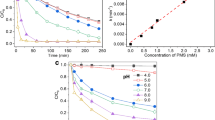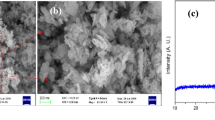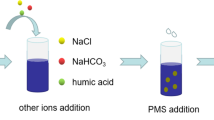Abstract
In this study, the azo dye acid orange 7 (AO7) was degraded by synergistic activation of persulfate (PMS) with cyclohexanone/chloride ion (Cl−). The effects of cyclohexanone dosage, PMS concentration, Cl− concentration, initial pH, temperature, and aqueous natural organic matter (NOM) on the AO7 removal were investigated. Under alkaline conditions, the removal rate of AO7 increased with increasing cyclohexanone and Cl− concentrations. The degradation rate of AO7 was unaffected by the water matrix and NOM in the environment. As shown in radical quenching experiments and electron paramagnetic resonance spectroscopy analysis, the main reactive species generated in the reaction system were hypochlorous acid (HCIO) and singlet oxygen (lO2), which destroyed the azo bond and naphthalene ring structure in AO7. Judging from its ability to degrade AO7, the cyclohexanone/Cl−/PMS system is suitable for treating high-salt wastewater containing organic pollutants.














Similar content being viewed by others
Data Availability
All data generated or analysed during this study are included in this published article.
References
Ball, R. E., Edwards, J. O., Haggett, M. L., & Jones, P. (1967). A kinetic and isotopic study of the decomposition of monoperoxyphthalic acid. Journal of the American Chemical Society, 89(10), 2331–2333.
Chan, K. H., & Chu, W. (2009). Degradation of atrazine by cobalt-mediated activation of peroxymonosulfate: Different cobalt counteranions in homogenous process and cobalt oxide catalysts in photolytic heterogeneous process. Water Research, 43(9), 2513–2521.
Chen, J., Dong, Y., & Li, C. (2007). Decoloration of three azo dyes in water by photocatalysis of Fe (III)-oxalate complexes/H2O2 in the presence of inorganic salts. Dyes and Pigments, 73(26), 261–268.
Chen, J., Zhang, L., Huang, T., Li, W., Wang, Y., & Wang, Z. (2016). Decolorization of azo dye by peroxymonosulfate activated by carbon nanotube: Radical versus non-radical mechanism. Journal of Hazardous Materials, 320(dec.15), 571–580.
Chen, J., Fang, C., Xia, W., Huang, T., & Huang, C. H. (2018a). Selective transformation of β-lactam antibiotics by peroxymonosulfate: Reaction kinetics and nonradical mechanism. Environmental Science and Technology, 52(3), 1461–1470.
Chen, X., Hu, X., & Gao, Y. (2018b). Removal of NO in simulated flue with aqueous solution of peroxymonosulfate activated by high temperature and Fe(II). Chemical Engineering Journal, 359, 419–427.
Cheng, X., Guo, H., Zhang, Y., Wu, X., & Liu, Y. (2017). Non-photochemical production of singlet oxygen via activation of persulfate by carbon nanotubes. Water Research A Journal of the International Water Association, 113, 80–88.
Chengdu, et al. (2016). Activation of peroxymonosulfate by base: Implications for the degradation of organic pollutants. Chemosphere, 151, 280–288.
Collivignarelli, M. C., Abba, A., Miino, M. C., & Damiani, S. (2019). Treatments for color removal from wastewater: State of the art. Journal of Environmental Management, 236(APR.15), 727–745.
Duan, X., Sun, H., Ao, Z., Zhou, L., Wang, G., & Wang, S. (2016). Unveiling the active sites of graphene-catalyzed peroxymonosulfate activation. Carbon, 107, 371–378.
Duan, X., Su, C., Miao, J., Zhong, Y., Shao, Z., Wang, S., & Sun, H. (2018). Insights into perovskite-catalyzed peroxymonosulfate activation: Maneuverable cobalt sites for promoted evolution of sulfate radicals. Applied Catalysis B Environmental, S122909304X.
Fang, C., Xiao, D., Liu, W., Lou, X., Zhou, J., Wang, Z., & Liu, J. (2016). Enhanced AOX accumulation and aquatic toxicity during 2,4,6-trichlorophenol degradation in a Co(II)/peroxymonosulfate/Cl system. Chemosphere, 144, 2415–2420.
Guan, Y.-H., Ma, J., Liu, D.-K., Ou, Z.-F., Zhang, W., Gong, X.-L., Fu, Q., & Crittenden, J. C. (2018). Insight into chloride effect on the UV/peroxymonosulfate process. Chemical Engineering Journal, 352, 477–489.
Güpta, Y. K. (1961). Iodometric determination of persulphate in sulphuric acid solution. Fresenius’ Zeitschrift für Analytische Chemie, 180(4), 260–265. https://doi.org/10.1007/bf00463208
Huang, J., Li, X., Ma, M., & Li, D. (2017a). Removal of di-(2-ethylhexyl) phthalate from aqueous solution by UV/peroxymonosulfate: Influencing factors and reaction pathways - ScienceDirect. Chemical Engineering Journal, 314, 182–191.
Huang, Y., Wang, Z., Liu, Q., Wang, X., Yuan, Z., & Liu, J. (2017b). Effects of chloride on PMS-based pollutant degradation: A substantial discrepancy between dyes and their common decomposition intermediate (phthalic acid). Chemosphere, 187(nov.), 338.
Huang, Y., Tian, X., Nie, Y., Yang, C., & Wang, Y. (2018). Enhanced peroxymonosulfate activation for phenol degradation over MnO_2 at pH 3.5–9.0 via Cu(II) substitution. Journal of Hazardous Materials, 360(OCT.15), 303–310.
Javier, R. F., & Solís, R. R. (2018). Chloride promoted oxidation of tritosulfuron by peroxymonosulfate. Chemical Engineering Journal, 349, 728–736.
Ji, Y., Kong, D., Lu, J., Jin, H., Kang, F., Yin, X., & Zhou, Q. (2016). Cobalt catalyzed peroxymonosulfate oxidation of tetrabromobisphenol A: Kinetics, reaction pathways, and formation of brominated by-products. Journal of Hazardous Materials, 313(Aug.5), 229–237.
Jiang, F., Qiu, B., & Sun, D. (2018). Advanced degradation of refractory pollutants in incineration leachate by UV/Peroxymonosulfate. Chemical Engineering Journal, 349, 338–346.
Kirubanandam, G., Jaikumar, P. V., Kumar, S., Selvam, P., & Rajan, S. (2019). A review on cleaner strategies for chromium industrial wastewater: Present research and future perspective. Journal of Cleaner Production, 228(1), 580–593.
Lange, A., & Brauer, H. D. (1996). On the formation of dioxiranes and of singlet oxygen by the ketone-catalysed decomposition of Caro’s acid. Journal of the Chemical Society Perkin Transactions, 2(5), 805–811.
Liang, C., & Bruell, C. J. (2008). Thermally activated persulfate oxidation of trichloroethylene: Experimental investigation of reaction orders. Industrial and Engineering Chemistry Research, 47(9), 2912–2918.
Liang, P., Zhang, C., Duan, X., Sun, H., Liu, S., Tade, M. O., & Wang, S. (2017). An insight into metal organic framework derived N-doped graphene for the oxidative degradation of persistent contaminants: Formation mechanism and generation of singlet oxygen from peroxymonosulfate. Environmental Science: Nano, 4(2), 315–324.
Lin, K.-Y. A., Chen, Y.-C., & Lin, Y.-F. (2017). LaMO3 perovskites (M=Co, Cu, Fe and Ni) as heterogeneous catalysts for activating peroxymonosulfate in water. Chemical Engineering Science, 160, 96–105.
Long, Y., Bu, S., Huang, Y., Shao, Y., Xiao, L., & Shi, X. (2019). N-doped hierarchically porous carbon for highly efficient metal-free catalytic activation of peroxymonosulfate in water: A non-radical mechanism. Chemosphere, 216, 545–555.
Luo, R., Li, M., Wang, C., Zhang, M., Khan, M. A. N., Sun, X., Shen, J., Han, W., Wang, L., & Li, J. (2019). Singlet oxygen-dominated non-radical oxidation process for efficient degradation of bisphenol A under high salinity condition. Water Resources, 1, 416–424.
Mahdi-Ahmed, M., & Chiron, S. (2014). Ciprofloxacin oxidation by UV-C activated peroxymonosulfate in wastewater. Journal of Hazardous Materials, 265, 41–46.
Malaviya, P., & Singh, A. (2011). Physicochemical technologies for remediation of chromium-containing waters and wastewaters. Critical Reviews in Environmental Science and Technology, 41(12), 1111–1172.
Miklos, et al. (2018). Evaluation of advanced oxidation processes for water and wastewater treatment - A critical review. Water Research: A Journal of the International Water Association, 139(Aug.1), 118–131.
Montgomery, R. E. (2002). Catalysis of peroxymonosulfate reactions by ketones. Journal of the American Chemical Society, 96(25), 7820–7821.
Muthukumar, M., & Selvakumar, N. (2004). Studies on the effect of inorganic salts on decolouration of acid dye effluents by ozonation. Dyes & Pigments, 62(3), 221–228.
Nihemaiti, M., Miklos, D. B., Hübner, U., Linden, K. G., Drewes, J. E., & Croué, J.-P. (2018). Removal of trace organic chemicals in wastewater effluent by UV/H2O2 and UV/PDS. Water Resources, 145, 487–497.
Oturan, M. A., & Aaron, J. J. (2014). Advanced oxidation processes in water/wastewater treatment: principles and applications. A review. Critical Reviews in Environmental Science & Technology, 44(23), 2577–2641.
Sang, K. H., Hwang, T. M., Yoon, Y., & Kang, J. W. (2011). Evidence of singlet oxygen and hydroxyl radical formation in aqueous goethite suspension using spin-trapping electron paramagnetic resonance (EPR). Chemosphere, 84(8), 1095–1101.
Selvam, K., Swaminathan, K., & Chae, K. (2003). Microbial decolorization of azo dyes and dye industry effluent by Fomes lividus. World Journal of Microbiology and Biotechnology, 19(6), 591–593. https://doi.org/10.1023/A:1025128327853
Tao, Z., Li, W., & Croué, J. P. (2012). A non-acid-assisted and non-hydroxyl-radical-related catalytic ozonation with ceria supported copper oxide in efficient oxalate degradation in water. Applied Catalysis B Environmental, 121–122(none), 88–94.
Tao, Z., Yin, C., Wang, Y., Roux, J. L., Yang, Y., & Croue, J. P. (2014). Efficient peroxydisulfate activation process not relying on sulfate radical generation for water pollutant degradation. Environmental Science & Technology, 48(10), 5868–5875.
Verma, S., Nakamura, S., & Sillanp, M. (2016). Application of UV-C LED activated PMS for the degradation of anatoxin-a. Chemical Engineering Journal, 284, 122–129.
Wang, S., & Wang, J. (2019). Oxidative removal of carbamazepine by peroxymonosulfate (PMS) combined to ionizing radiation: Degradation, mineralization and biological toxicity. The Science of the Total Environment, 658, 1367–1374.
Wang, Z., Yuan, R., Guo, Y., Lei, X., & Liu, J. (2011). Effects of chloride ions on bleaching of azo dyes by Co2+/oxone reagent: Kinetic analysis. Journal of Hazardous Materials, 190(1–3), 1083–1087.
Wang, Y., Cao, D., Liu, M., & Zhao, X. (2017). Insights into heterogeneous catalytic activation of peroxymonosulfate by Pd/g-C 3 N 4: The role of superoxide radical and singlet oxygen. Catalysis Communications, 102, 85–88.
Wang, L., Kong, D., Ji, Y., Lu, J., Yin, X., & Zhou, Q. (2018a). Formation of halogenated disinfection byproducts during the degradation of chlorophenols by peroxymonosulfate oxidation in the presence of bromide. Chemical Engineering Journal, 343, 235–243.
Wang, Y., et al. (2018b). Enhanced performance and microbial community analysis of bioelectrochemical system integrated with bio-contact oxidation reactor for treatment of wastewater containing azo dye. The Science of the Total Environment, 634(SEP.1), 616–627.
Xiao-Yi, et al. (2013). Rapid dye degradation with reactive oxidants generated by chloride-induced peroxymonosulfate activation. Environmental Science&pollution Research, 20(9), 6317–6323.
Yang, S., Xin, Y., Shao, X., Niu, R., & Wang, L. (2011). Activated carbon catalyzed persulfate oxidation of Azo dye acid orange 7 at ambient temperature. Journal of Hazardous Materials, 186(1), 659–666.
Yang, F., Huang, Y., Fang, C., Xue, Y., Ai, Y., Liu, J., & Wang, Z. (2018a). Peroxymonosulfate/base process in saline wastewater treatment: The fight between alkalinity and chloride ions. Chemosphere Environmental Toxicology & Risk Assessment, 199(5), 88–84.
Yang, Y., Banerj Ee, G., Brudvig, G. W., Kim, J. H., & Pignatello, J. J. (2018b). Oxidation of organic compounds in water by unactivated peroxymonosulfate. Environmental Science and Technology, 52(10), 5911–5919.
Yuan, R., Ramjaun, S. N., Wang, Z., & Liu, J. (2011). Effects of chloride ion on degradation of Acid Orange 7 by sulfate radical-based advanced oxidation process: Implications for formation of chlorinated aromatic compounds - ScienceDirect. Journal of Hazardous Materials, 196(1), 173–179.
Zhang, X., Yao, J., Zhao, Z., & Liu, J. (2019). Degradation of haloacetonitriles with UV/peroxymonosulfate process: Degradation pathway and the role of hydroxyl radicals. Chemical Engineering Journal, 364, 1–10.
Zhou, Y., Jiang, J., Gao, Y., Ma, J., Pang, S.-Y., Li, J., Lu, X.-T., & Yuan, L.-P. (2015). Activation of peroxymonosulfate by benzoquinone: A novel nonradical oxidation process. Environmental Science and Technology, 49(21), 12491–50.
Ziarani, G., Moradi, R., Lashgari, N., & Kruger, H. G. (2018). Metal-free synthetic organic dyes. Phenothiazine Dyes, 179–183. https://doi.org/10.1016/B978-0-12-815647-6.00013-3
Acknowledgements
We sincerely thank the National Natural Science Foundation of China (51778391) and (2022001) for financially supporting this work.
Author information
Authors and Affiliations
Contributions
Authors’ individual contributions to the paper: Wei Wu: conceptualization, methodology, supervision, investigation, validation, writing-reviewing and editing; Huike Duan: investigation, data curation, validation, writing-original draft; Jie Xu: methodology, investigation; Fen Xu: investigation, data curation, formal analysis; Jiabin Chen: conceptualization, methodology, investigation, validation; Tianying Huang: conceptualization, methodology, supervision; Xiaoyi Xu: formal analysis, investigation, data curation, validation. All authors read and approved the final manuscript.
Corresponding author
Ethics declarations
Conflict of Interest
The authors declare no competing interests.
Additional information
Publisher's Note
Springer Nature remains neutral with regard to jurisdictional claims in published maps and institutional affiliations.
Rights and permissions
Springer Nature or its licensor holds exclusive rights to this article under a publishing agreement with the author(s) or other rightsholder(s); author self-archiving of the accepted manuscript version of this article is solely governed by the terms of such publishing agreement and applicable law.
About this article
Cite this article
Wu, W., Duan, H., Chen, J. et al. Catalytic Effect of Cyclohexanone Combined with Chloride Ion Activation of Peroxomonosulfate to Degrade Acid Orange 7. Water Air Soil Pollut 233, 381 (2022). https://doi.org/10.1007/s11270-022-05848-7
Received:
Accepted:
Published:
DOI: https://doi.org/10.1007/s11270-022-05848-7




